Global Social Media Risks: Government Regulations and Market Expansion
VerifiedAdded on 2023/03/31
|12
|2164
|254
Report
AI Summary
This report examines the escalating global risks confronting social media organizations such as Facebook, Twitter, and Instagram, stemming from both proposed and enacted government regulations. It delves into the potential impacts of these regulations, including substantial fines, operational restrictions, and liabilities for individual managers. The analysis extends to the opportunities presented by emerging markets for global business expansion, highlighting the characteristics that define these markets and the strategies multinational companies can employ to capitalize on them. The report concludes that while regulations pose challenges, emerging markets offer significant growth potential, provided businesses adopt structured marketing plans and effectively segment their target markets. Desklib provides a platform to access this document and many other solved assignments.
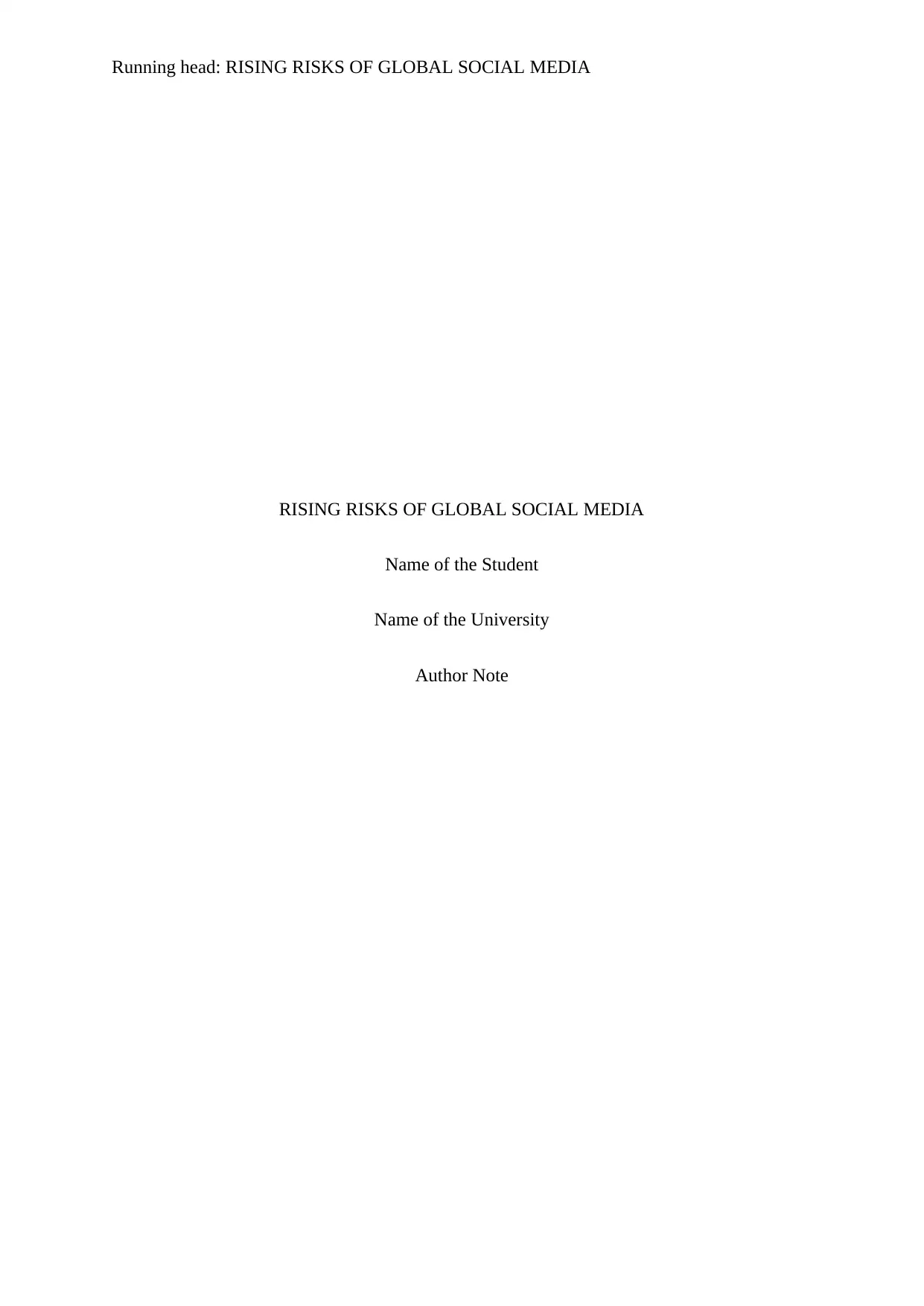
Running head: RISING RISKS OF GLOBAL SOCIAL MEDIA
RISING RISKS OF GLOBAL SOCIAL MEDIA
Name of the Student
Name of the University
Author Note
RISING RISKS OF GLOBAL SOCIAL MEDIA
Name of the Student
Name of the University
Author Note
Paraphrase This Document
Need a fresh take? Get an instant paraphrase of this document with our AI Paraphraser
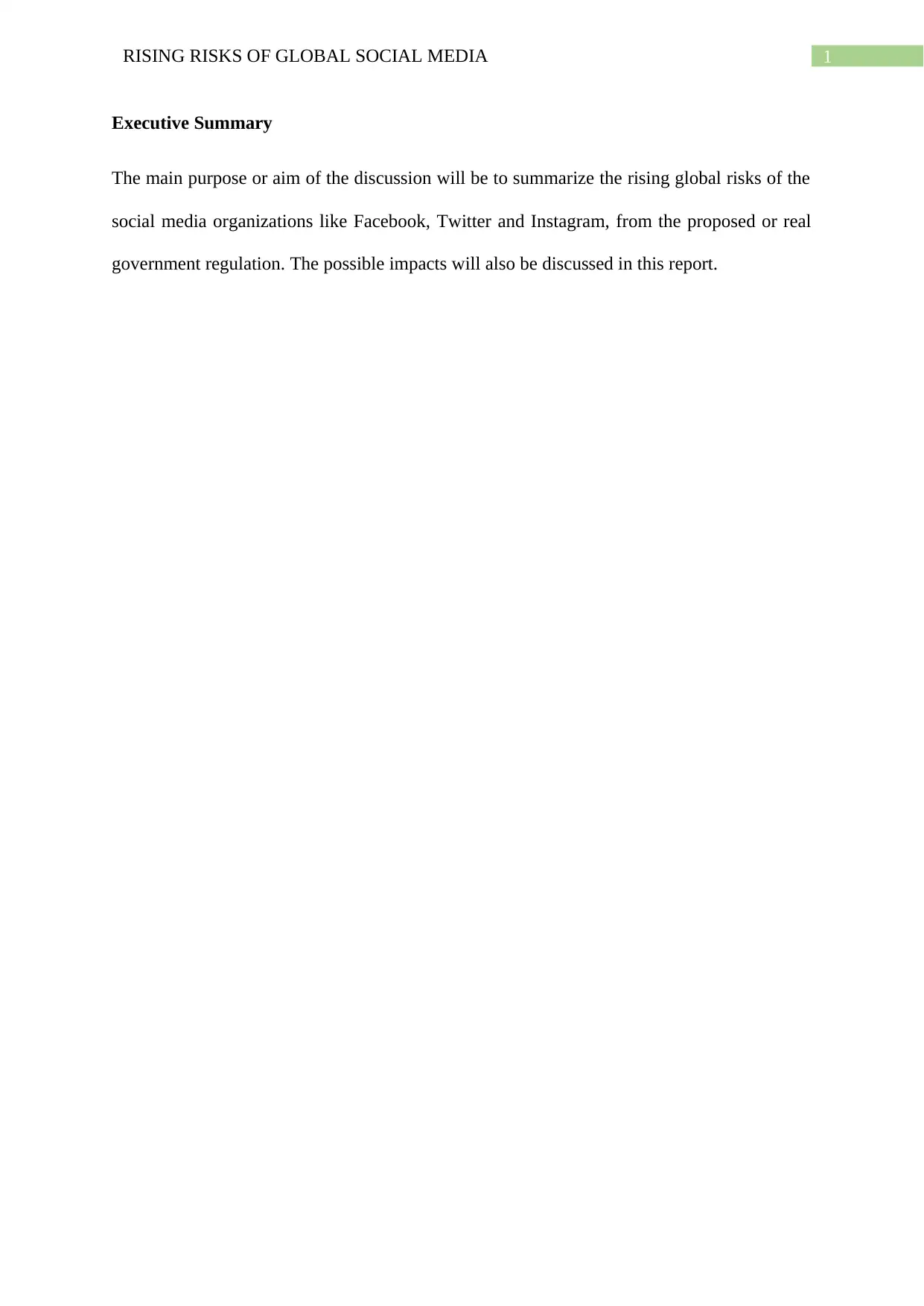
1RISING RISKS OF GLOBAL SOCIAL MEDIA
Executive Summary
The main purpose or aim of the discussion will be to summarize the rising global risks of the
social media organizations like Facebook, Twitter and Instagram, from the proposed or real
government regulation. The possible impacts will also be discussed in this report.
Executive Summary
The main purpose or aim of the discussion will be to summarize the rising global risks of the
social media organizations like Facebook, Twitter and Instagram, from the proposed or real
government regulation. The possible impacts will also be discussed in this report.
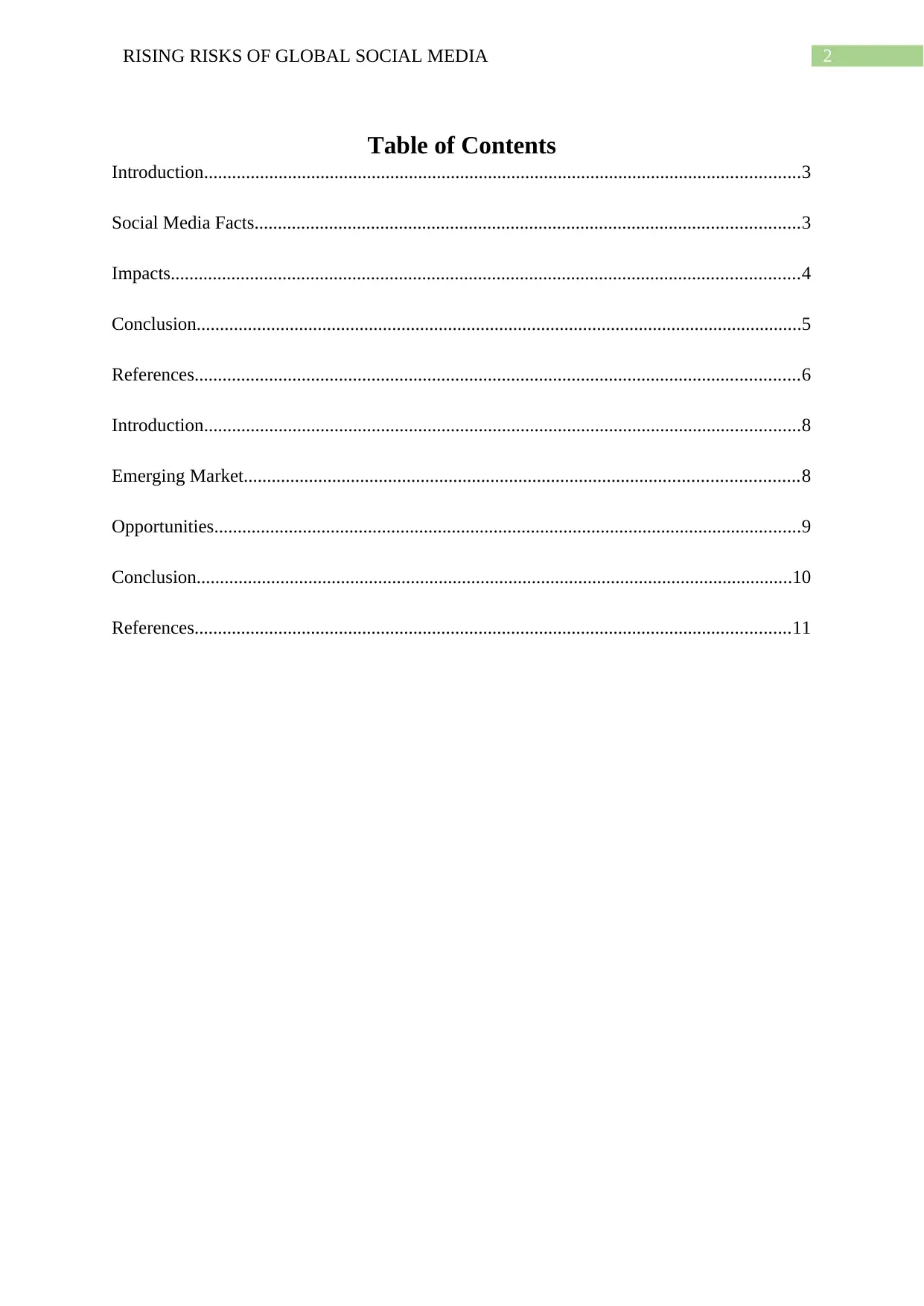
2RISING RISKS OF GLOBAL SOCIAL MEDIA
Table of Contents
Introduction................................................................................................................................3
Social Media Facts.....................................................................................................................3
Impacts.......................................................................................................................................4
Conclusion..................................................................................................................................5
References..................................................................................................................................6
Introduction................................................................................................................................8
Emerging Market.......................................................................................................................8
Opportunities..............................................................................................................................9
Conclusion................................................................................................................................10
References................................................................................................................................11
Table of Contents
Introduction................................................................................................................................3
Social Media Facts.....................................................................................................................3
Impacts.......................................................................................................................................4
Conclusion..................................................................................................................................5
References..................................................................................................................................6
Introduction................................................................................................................................8
Emerging Market.......................................................................................................................8
Opportunities..............................................................................................................................9
Conclusion................................................................................................................................10
References................................................................................................................................11
⊘ This is a preview!⊘
Do you want full access?
Subscribe today to unlock all pages.

Trusted by 1+ million students worldwide
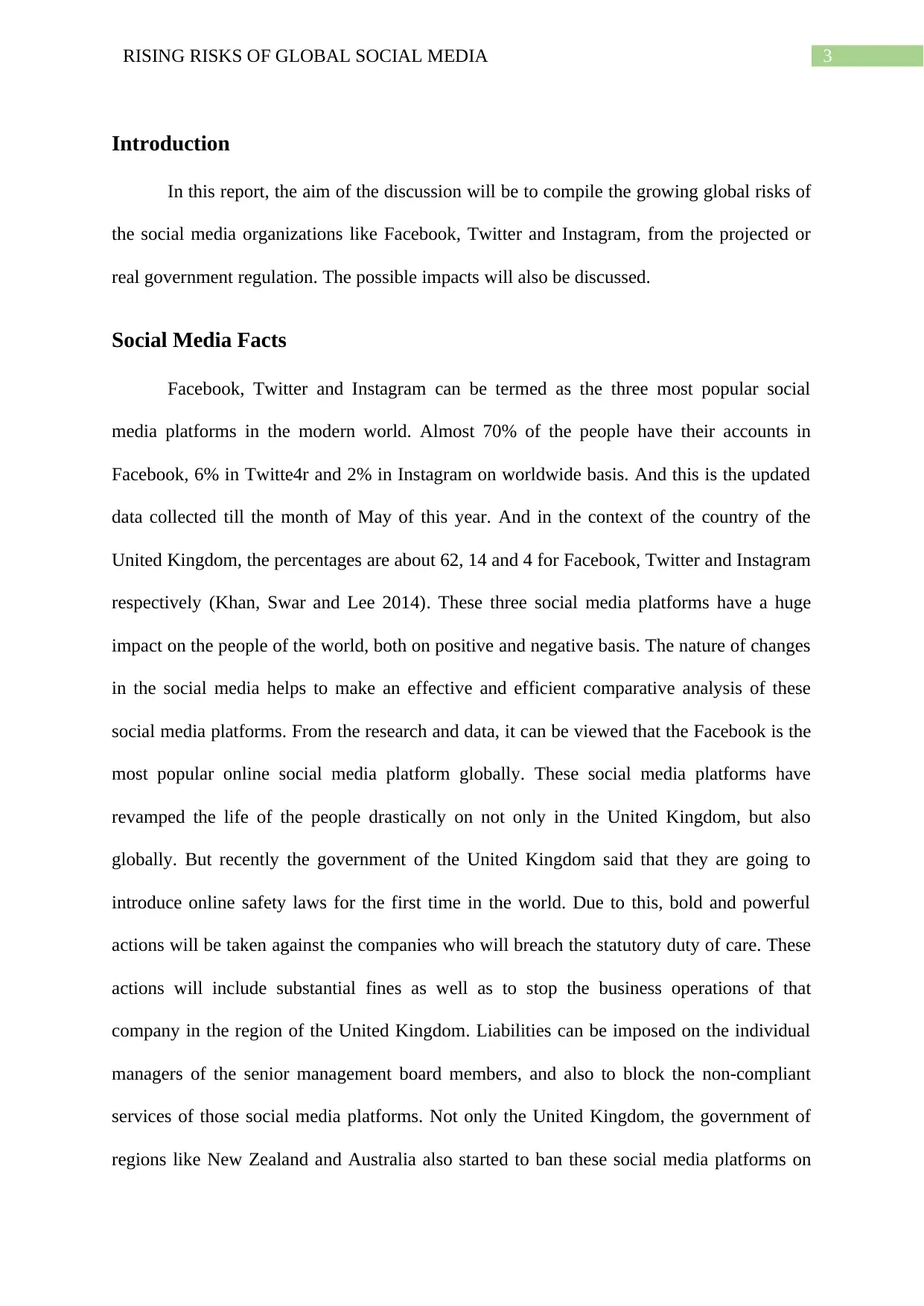
3RISING RISKS OF GLOBAL SOCIAL MEDIA
Introduction
In this report, the aim of the discussion will be to compile the growing global risks of
the social media organizations like Facebook, Twitter and Instagram, from the projected or
real government regulation. The possible impacts will also be discussed.
Social Media Facts
Facebook, Twitter and Instagram can be termed as the three most popular social
media platforms in the modern world. Almost 70% of the people have their accounts in
Facebook, 6% in Twitte4r and 2% in Instagram on worldwide basis. And this is the updated
data collected till the month of May of this year. And in the context of the country of the
United Kingdom, the percentages are about 62, 14 and 4 for Facebook, Twitter and Instagram
respectively (Khan, Swar and Lee 2014). These three social media platforms have a huge
impact on the people of the world, both on positive and negative basis. The nature of changes
in the social media helps to make an effective and efficient comparative analysis of these
social media platforms. From the research and data, it can be viewed that the Facebook is the
most popular online social media platform globally. These social media platforms have
revamped the life of the people drastically on not only in the United Kingdom, but also
globally. But recently the government of the United Kingdom said that they are going to
introduce online safety laws for the first time in the world. Due to this, bold and powerful
actions will be taken against the companies who will breach the statutory duty of care. These
actions will include substantial fines as well as to stop the business operations of that
company in the region of the United Kingdom. Liabilities can be imposed on the individual
managers of the senior management board members, and also to block the non-compliant
services of those social media platforms. Not only the United Kingdom, the government of
regions like New Zealand and Australia also started to ban these social media platforms on
Introduction
In this report, the aim of the discussion will be to compile the growing global risks of
the social media organizations like Facebook, Twitter and Instagram, from the projected or
real government regulation. The possible impacts will also be discussed.
Social Media Facts
Facebook, Twitter and Instagram can be termed as the three most popular social
media platforms in the modern world. Almost 70% of the people have their accounts in
Facebook, 6% in Twitte4r and 2% in Instagram on worldwide basis. And this is the updated
data collected till the month of May of this year. And in the context of the country of the
United Kingdom, the percentages are about 62, 14 and 4 for Facebook, Twitter and Instagram
respectively (Khan, Swar and Lee 2014). These three social media platforms have a huge
impact on the people of the world, both on positive and negative basis. The nature of changes
in the social media helps to make an effective and efficient comparative analysis of these
social media platforms. From the research and data, it can be viewed that the Facebook is the
most popular online social media platform globally. These social media platforms have
revamped the life of the people drastically on not only in the United Kingdom, but also
globally. But recently the government of the United Kingdom said that they are going to
introduce online safety laws for the first time in the world. Due to this, bold and powerful
actions will be taken against the companies who will breach the statutory duty of care. These
actions will include substantial fines as well as to stop the business operations of that
company in the region of the United Kingdom. Liabilities can be imposed on the individual
managers of the senior management board members, and also to block the non-compliant
services of those social media platforms. Not only the United Kingdom, the government of
regions like New Zealand and Australia also started to ban these social media platforms on
Paraphrase This Document
Need a fresh take? Get an instant paraphrase of this document with our AI Paraphraser
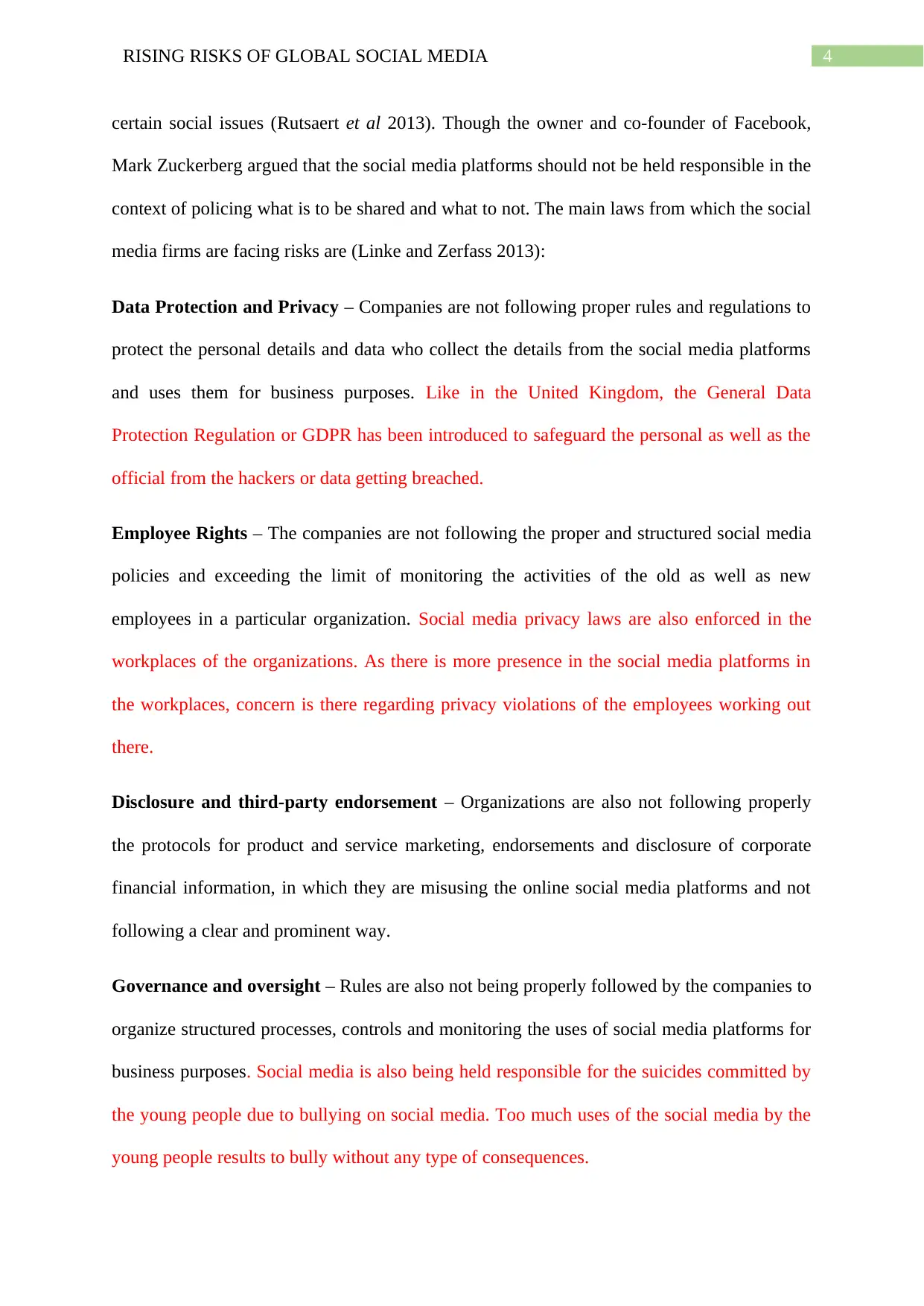
4RISING RISKS OF GLOBAL SOCIAL MEDIA
certain social issues (Rutsaert et al 2013). Though the owner and co-founder of Facebook,
Mark Zuckerberg argued that the social media platforms should not be held responsible in the
context of policing what is to be shared and what to not. The main laws from which the social
media firms are facing risks are (Linke and Zerfass 2013):
Data Protection and Privacy – Companies are not following proper rules and regulations to
protect the personal details and data who collect the details from the social media platforms
and uses them for business purposes. Like in the United Kingdom, the General Data
Protection Regulation or GDPR has been introduced to safeguard the personal as well as the
official from the hackers or data getting breached.
Employee Rights – The companies are not following the proper and structured social media
policies and exceeding the limit of monitoring the activities of the old as well as new
employees in a particular organization. Social media privacy laws are also enforced in the
workplaces of the organizations. As there is more presence in the social media platforms in
the workplaces, concern is there regarding privacy violations of the employees working out
there.
Disclosure and third-party endorsement – Organizations are also not following properly
the protocols for product and service marketing, endorsements and disclosure of corporate
financial information, in which they are misusing the online social media platforms and not
following a clear and prominent way.
Governance and oversight – Rules are also not being properly followed by the companies to
organize structured processes, controls and monitoring the uses of social media platforms for
business purposes. Social media is also being held responsible for the suicides committed by
the young people due to bullying on social media. Too much uses of the social media by the
young people results to bully without any type of consequences.
certain social issues (Rutsaert et al 2013). Though the owner and co-founder of Facebook,
Mark Zuckerberg argued that the social media platforms should not be held responsible in the
context of policing what is to be shared and what to not. The main laws from which the social
media firms are facing risks are (Linke and Zerfass 2013):
Data Protection and Privacy – Companies are not following proper rules and regulations to
protect the personal details and data who collect the details from the social media platforms
and uses them for business purposes. Like in the United Kingdom, the General Data
Protection Regulation or GDPR has been introduced to safeguard the personal as well as the
official from the hackers or data getting breached.
Employee Rights – The companies are not following the proper and structured social media
policies and exceeding the limit of monitoring the activities of the old as well as new
employees in a particular organization. Social media privacy laws are also enforced in the
workplaces of the organizations. As there is more presence in the social media platforms in
the workplaces, concern is there regarding privacy violations of the employees working out
there.
Disclosure and third-party endorsement – Organizations are also not following properly
the protocols for product and service marketing, endorsements and disclosure of corporate
financial information, in which they are misusing the online social media platforms and not
following a clear and prominent way.
Governance and oversight – Rules are also not being properly followed by the companies to
organize structured processes, controls and monitoring the uses of social media platforms for
business purposes. Social media is also being held responsible for the suicides committed by
the young people due to bullying on social media. Too much uses of the social media by the
young people results to bully without any type of consequences.
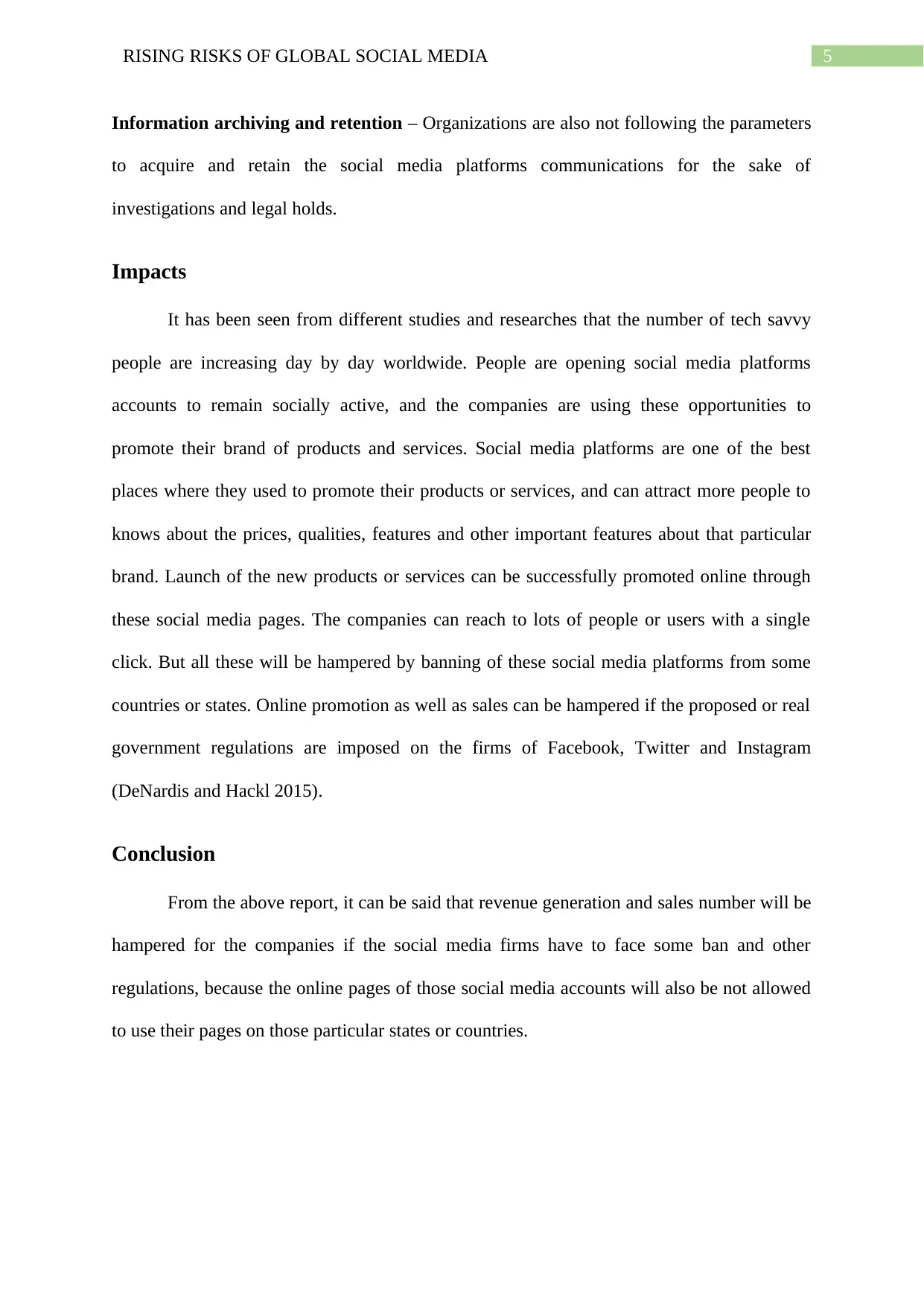
5RISING RISKS OF GLOBAL SOCIAL MEDIA
Information archiving and retention – Organizations are also not following the parameters
to acquire and retain the social media platforms communications for the sake of
investigations and legal holds.
Impacts
It has been seen from different studies and researches that the number of tech savvy
people are increasing day by day worldwide. People are opening social media platforms
accounts to remain socially active, and the companies are using these opportunities to
promote their brand of products and services. Social media platforms are one of the best
places where they used to promote their products or services, and can attract more people to
knows about the prices, qualities, features and other important features about that particular
brand. Launch of the new products or services can be successfully promoted online through
these social media pages. The companies can reach to lots of people or users with a single
click. But all these will be hampered by banning of these social media platforms from some
countries or states. Online promotion as well as sales can be hampered if the proposed or real
government regulations are imposed on the firms of Facebook, Twitter and Instagram
(DeNardis and Hackl 2015).
Conclusion
From the above report, it can be said that revenue generation and sales number will be
hampered for the companies if the social media firms have to face some ban and other
regulations, because the online pages of those social media accounts will also be not allowed
to use their pages on those particular states or countries.
Information archiving and retention – Organizations are also not following the parameters
to acquire and retain the social media platforms communications for the sake of
investigations and legal holds.
Impacts
It has been seen from different studies and researches that the number of tech savvy
people are increasing day by day worldwide. People are opening social media platforms
accounts to remain socially active, and the companies are using these opportunities to
promote their brand of products and services. Social media platforms are one of the best
places where they used to promote their products or services, and can attract more people to
knows about the prices, qualities, features and other important features about that particular
brand. Launch of the new products or services can be successfully promoted online through
these social media pages. The companies can reach to lots of people or users with a single
click. But all these will be hampered by banning of these social media platforms from some
countries or states. Online promotion as well as sales can be hampered if the proposed or real
government regulations are imposed on the firms of Facebook, Twitter and Instagram
(DeNardis and Hackl 2015).
Conclusion
From the above report, it can be said that revenue generation and sales number will be
hampered for the companies if the social media firms have to face some ban and other
regulations, because the online pages of those social media accounts will also be not allowed
to use their pages on those particular states or countries.
⊘ This is a preview!⊘
Do you want full access?
Subscribe today to unlock all pages.

Trusted by 1+ million students worldwide
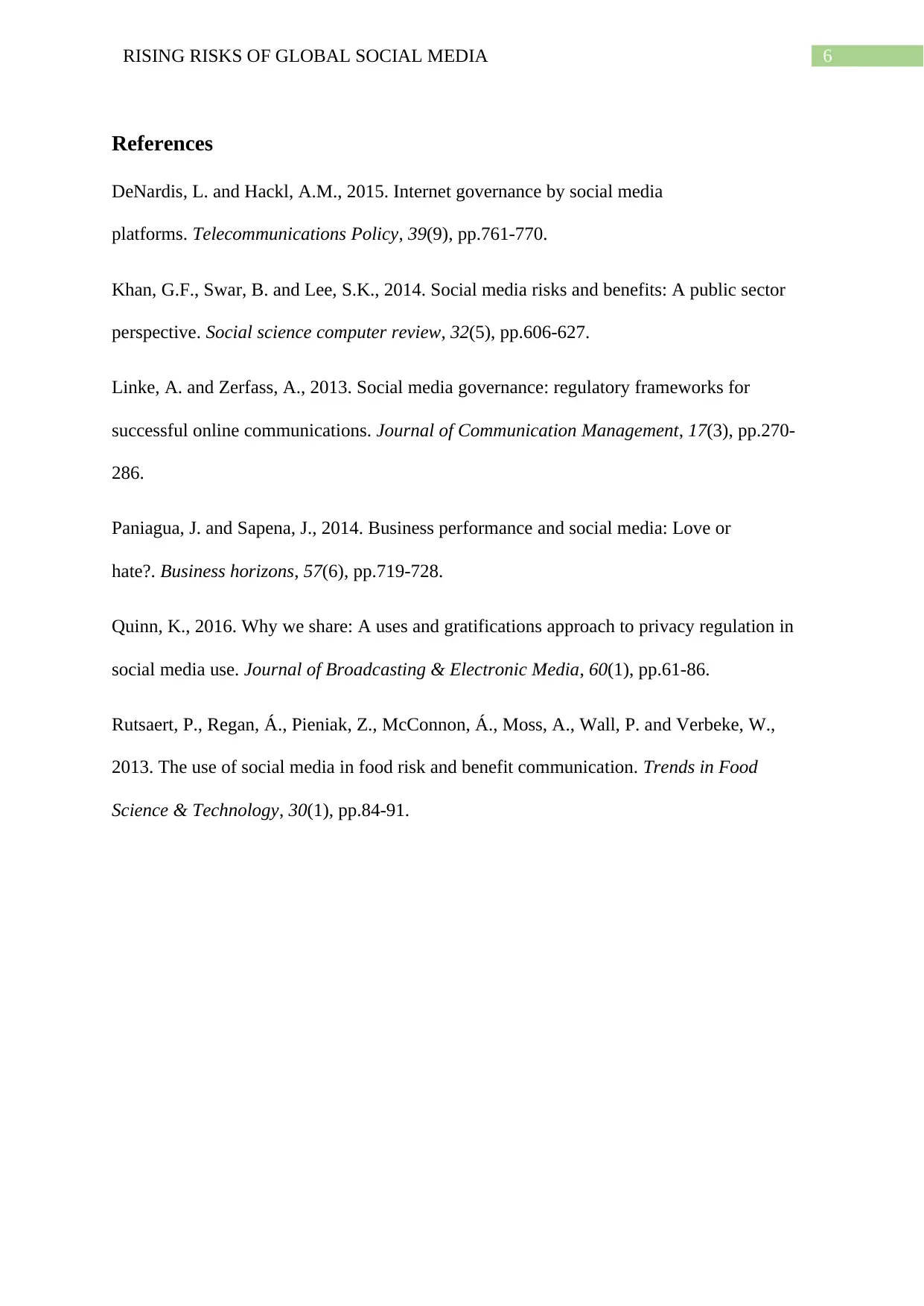
6RISING RISKS OF GLOBAL SOCIAL MEDIA
References
DeNardis, L. and Hackl, A.M., 2015. Internet governance by social media
platforms. Telecommunications Policy, 39(9), pp.761-770.
Khan, G.F., Swar, B. and Lee, S.K., 2014. Social media risks and benefits: A public sector
perspective. Social science computer review, 32(5), pp.606-627.
Linke, A. and Zerfass, A., 2013. Social media governance: regulatory frameworks for
successful online communications. Journal of Communication Management, 17(3), pp.270-
286.
Paniagua, J. and Sapena, J., 2014. Business performance and social media: Love or
hate?. Business horizons, 57(6), pp.719-728.
Quinn, K., 2016. Why we share: A uses and gratifications approach to privacy regulation in
social media use. Journal of Broadcasting & Electronic Media, 60(1), pp.61-86.
Rutsaert, P., Regan, Á., Pieniak, Z., McConnon, Á., Moss, A., Wall, P. and Verbeke, W.,
2013. The use of social media in food risk and benefit communication. Trends in Food
Science & Technology, 30(1), pp.84-91.
References
DeNardis, L. and Hackl, A.M., 2015. Internet governance by social media
platforms. Telecommunications Policy, 39(9), pp.761-770.
Khan, G.F., Swar, B. and Lee, S.K., 2014. Social media risks and benefits: A public sector
perspective. Social science computer review, 32(5), pp.606-627.
Linke, A. and Zerfass, A., 2013. Social media governance: regulatory frameworks for
successful online communications. Journal of Communication Management, 17(3), pp.270-
286.
Paniagua, J. and Sapena, J., 2014. Business performance and social media: Love or
hate?. Business horizons, 57(6), pp.719-728.
Quinn, K., 2016. Why we share: A uses and gratifications approach to privacy regulation in
social media use. Journal of Broadcasting & Electronic Media, 60(1), pp.61-86.
Rutsaert, P., Regan, Á., Pieniak, Z., McConnon, Á., Moss, A., Wall, P. and Verbeke, W.,
2013. The use of social media in food risk and benefit communication. Trends in Food
Science & Technology, 30(1), pp.84-91.
Paraphrase This Document
Need a fresh take? Get an instant paraphrase of this document with our AI Paraphraser
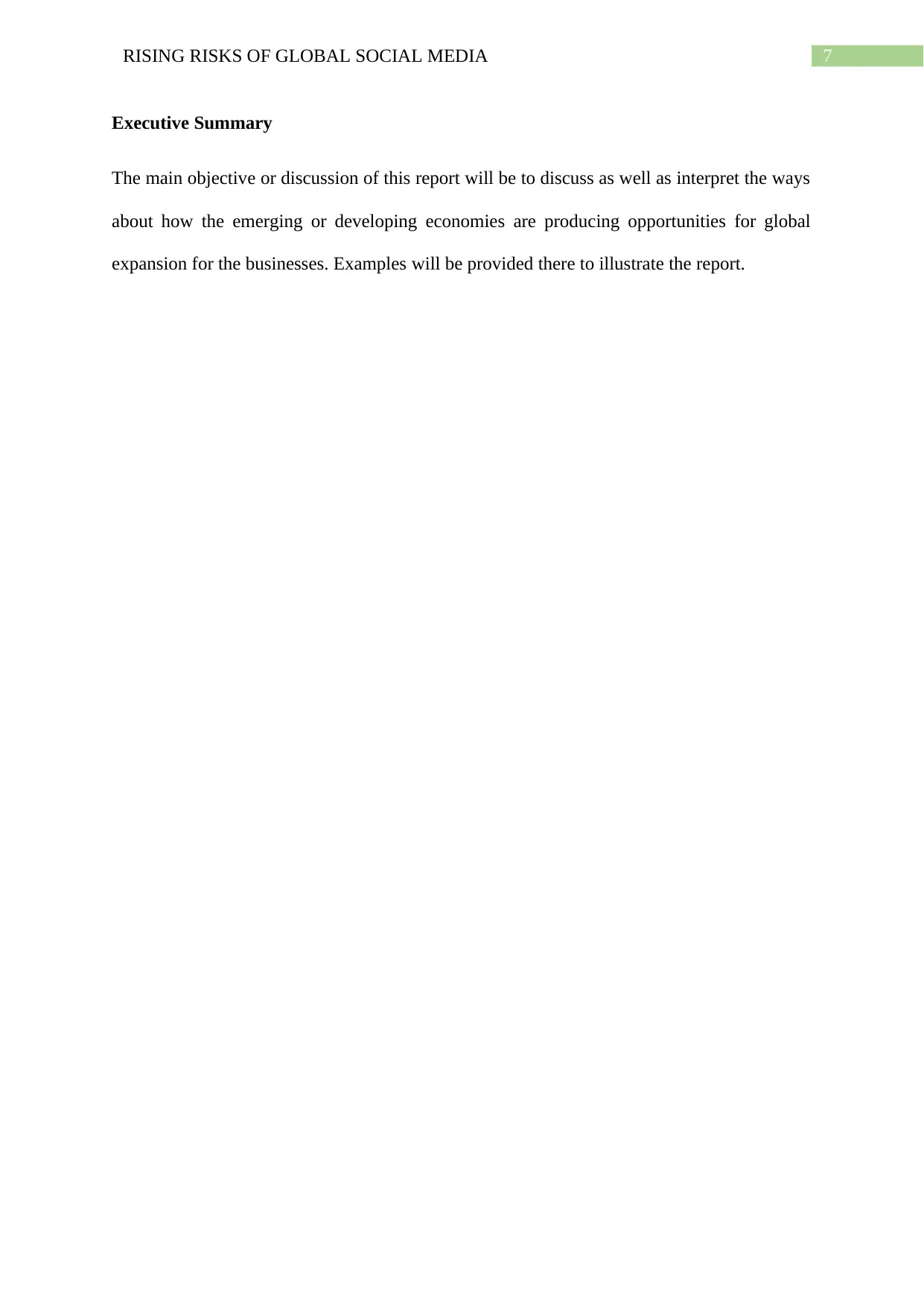
7RISING RISKS OF GLOBAL SOCIAL MEDIA
Executive Summary
The main objective or discussion of this report will be to discuss as well as interpret the ways
about how the emerging or developing economies are producing opportunities for global
expansion for the businesses. Examples will be provided there to illustrate the report.
Executive Summary
The main objective or discussion of this report will be to discuss as well as interpret the ways
about how the emerging or developing economies are producing opportunities for global
expansion for the businesses. Examples will be provided there to illustrate the report.
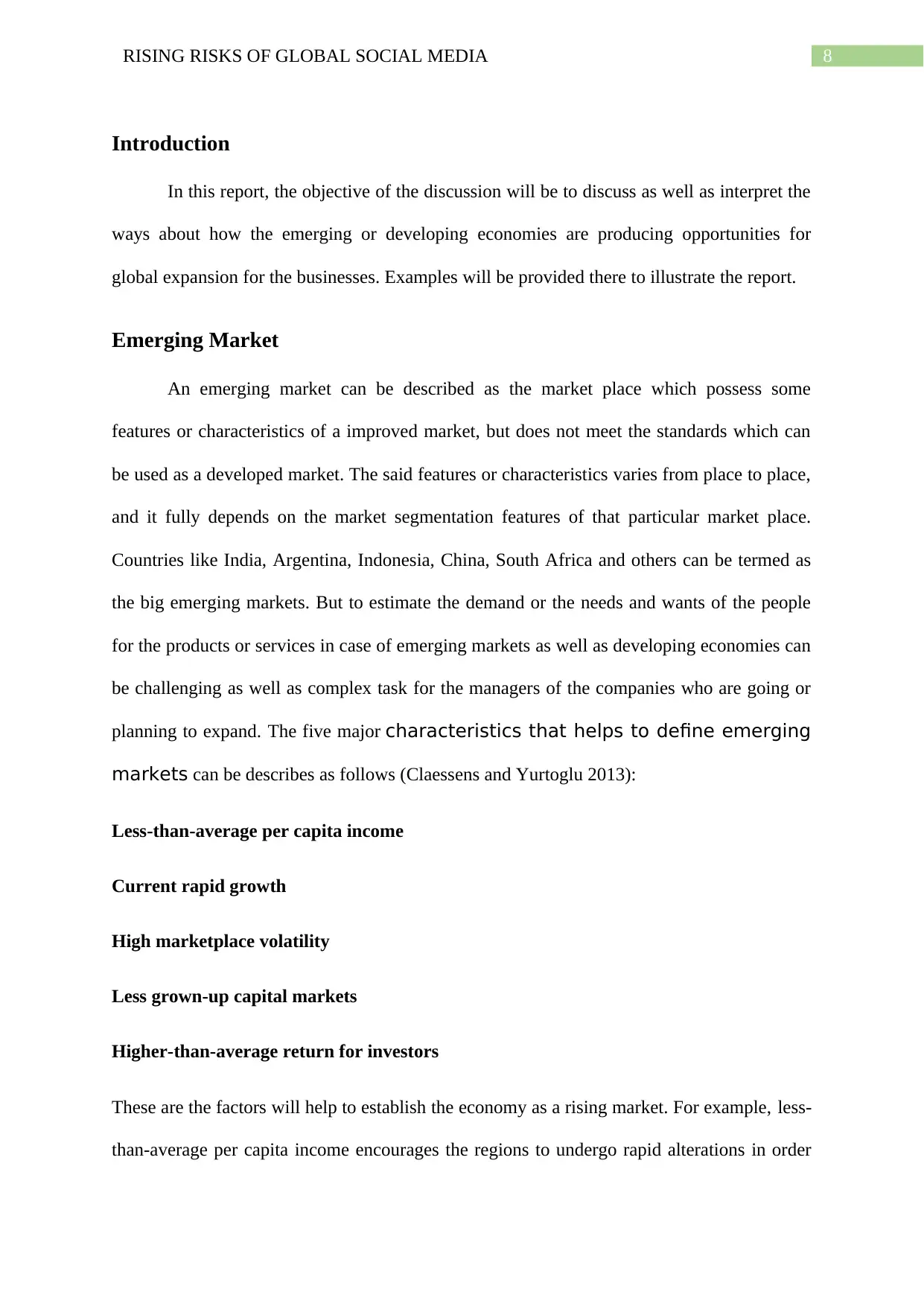
8RISING RISKS OF GLOBAL SOCIAL MEDIA
Introduction
In this report, the objective of the discussion will be to discuss as well as interpret the
ways about how the emerging or developing economies are producing opportunities for
global expansion for the businesses. Examples will be provided there to illustrate the report.
Emerging Market
An emerging market can be described as the market place which possess some
features or characteristics of a improved market, but does not meet the standards which can
be used as a developed market. The said features or characteristics varies from place to place,
and it fully depends on the market segmentation features of that particular market place.
Countries like India, Argentina, Indonesia, China, South Africa and others can be termed as
the big emerging markets. But to estimate the demand or the needs and wants of the people
for the products or services in case of emerging markets as well as developing economies can
be challenging as well as complex task for the managers of the companies who are going or
planning to expand. The five major characteristics that helps to define emerging
markets can be describes as follows (Claessens and Yurtoglu 2013):
Less-than-average per capita income
Current rapid growth
High marketplace volatility
Less grown-up capital markets
Higher-than-average return for investors
These are the factors will help to establish the economy as a rising market. For example, less-
than-average per capita income encourages the regions to undergo rapid alterations in order
Introduction
In this report, the objective of the discussion will be to discuss as well as interpret the
ways about how the emerging or developing economies are producing opportunities for
global expansion for the businesses. Examples will be provided there to illustrate the report.
Emerging Market
An emerging market can be described as the market place which possess some
features or characteristics of a improved market, but does not meet the standards which can
be used as a developed market. The said features or characteristics varies from place to place,
and it fully depends on the market segmentation features of that particular market place.
Countries like India, Argentina, Indonesia, China, South Africa and others can be termed as
the big emerging markets. But to estimate the demand or the needs and wants of the people
for the products or services in case of emerging markets as well as developing economies can
be challenging as well as complex task for the managers of the companies who are going or
planning to expand. The five major characteristics that helps to define emerging
markets can be describes as follows (Claessens and Yurtoglu 2013):
Less-than-average per capita income
Current rapid growth
High marketplace volatility
Less grown-up capital markets
Higher-than-average return for investors
These are the factors will help to establish the economy as a rising market. For example, less-
than-average per capita income encourages the regions to undergo rapid alterations in order
⊘ This is a preview!⊘
Do you want full access?
Subscribe today to unlock all pages.

Trusted by 1+ million students worldwide
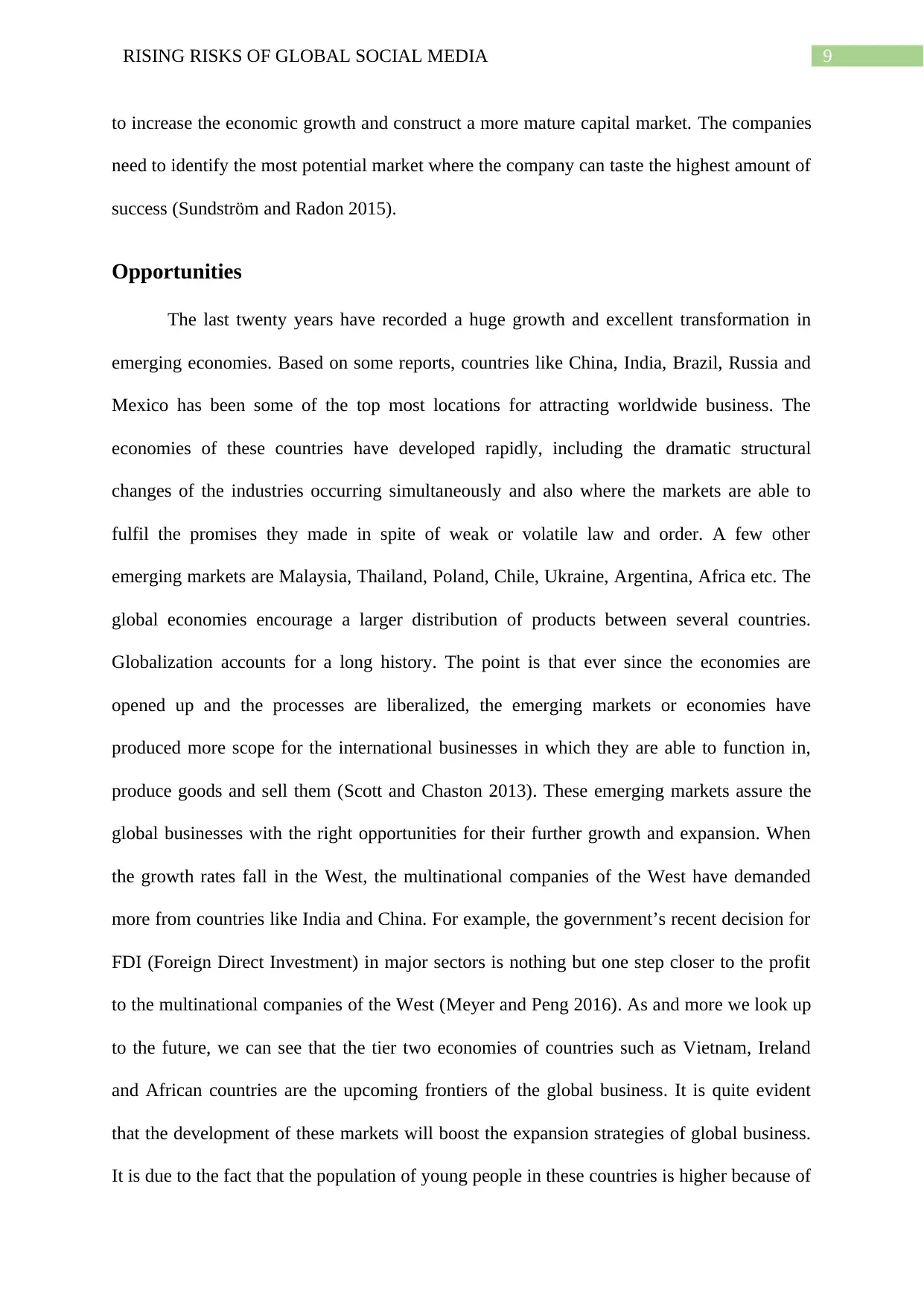
9RISING RISKS OF GLOBAL SOCIAL MEDIA
to increase the economic growth and construct a more mature capital market. The companies
need to identify the most potential market where the company can taste the highest amount of
success (Sundström and Radon 2015).
Opportunities
The last twenty years have recorded a huge growth and excellent transformation in
emerging economies. Based on some reports, countries like China, India, Brazil, Russia and
Mexico has been some of the top most locations for attracting worldwide business. The
economies of these countries have developed rapidly, including the dramatic structural
changes of the industries occurring simultaneously and also where the markets are able to
fulfil the promises they made in spite of weak or volatile law and order. A few other
emerging markets are Malaysia, Thailand, Poland, Chile, Ukraine, Argentina, Africa etc. The
global economies encourage a larger distribution of products between several countries.
Globalization accounts for a long history. The point is that ever since the economies are
opened up and the processes are liberalized, the emerging markets or economies have
produced more scope for the international businesses in which they are able to function in,
produce goods and sell them (Scott and Chaston 2013). These emerging markets assure the
global businesses with the right opportunities for their further growth and expansion. When
the growth rates fall in the West, the multinational companies of the West have demanded
more from countries like India and China. For example, the government’s recent decision for
FDI (Foreign Direct Investment) in major sectors is nothing but one step closer to the profit
to the multinational companies of the West (Meyer and Peng 2016). As and more we look up
to the future, we can see that the tier two economies of countries such as Vietnam, Ireland
and African countries are the upcoming frontiers of the global business. It is quite evident
that the development of these markets will boost the expansion strategies of global business.
It is due to the fact that the population of young people in these countries is higher because of
to increase the economic growth and construct a more mature capital market. The companies
need to identify the most potential market where the company can taste the highest amount of
success (Sundström and Radon 2015).
Opportunities
The last twenty years have recorded a huge growth and excellent transformation in
emerging economies. Based on some reports, countries like China, India, Brazil, Russia and
Mexico has been some of the top most locations for attracting worldwide business. The
economies of these countries have developed rapidly, including the dramatic structural
changes of the industries occurring simultaneously and also where the markets are able to
fulfil the promises they made in spite of weak or volatile law and order. A few other
emerging markets are Malaysia, Thailand, Poland, Chile, Ukraine, Argentina, Africa etc. The
global economies encourage a larger distribution of products between several countries.
Globalization accounts for a long history. The point is that ever since the economies are
opened up and the processes are liberalized, the emerging markets or economies have
produced more scope for the international businesses in which they are able to function in,
produce goods and sell them (Scott and Chaston 2013). These emerging markets assure the
global businesses with the right opportunities for their further growth and expansion. When
the growth rates fall in the West, the multinational companies of the West have demanded
more from countries like India and China. For example, the government’s recent decision for
FDI (Foreign Direct Investment) in major sectors is nothing but one step closer to the profit
to the multinational companies of the West (Meyer and Peng 2016). As and more we look up
to the future, we can see that the tier two economies of countries such as Vietnam, Ireland
and African countries are the upcoming frontiers of the global business. It is quite evident
that the development of these markets will boost the expansion strategies of global business.
It is due to the fact that the population of young people in these countries is higher because of
Paraphrase This Document
Need a fresh take? Get an instant paraphrase of this document with our AI Paraphraser
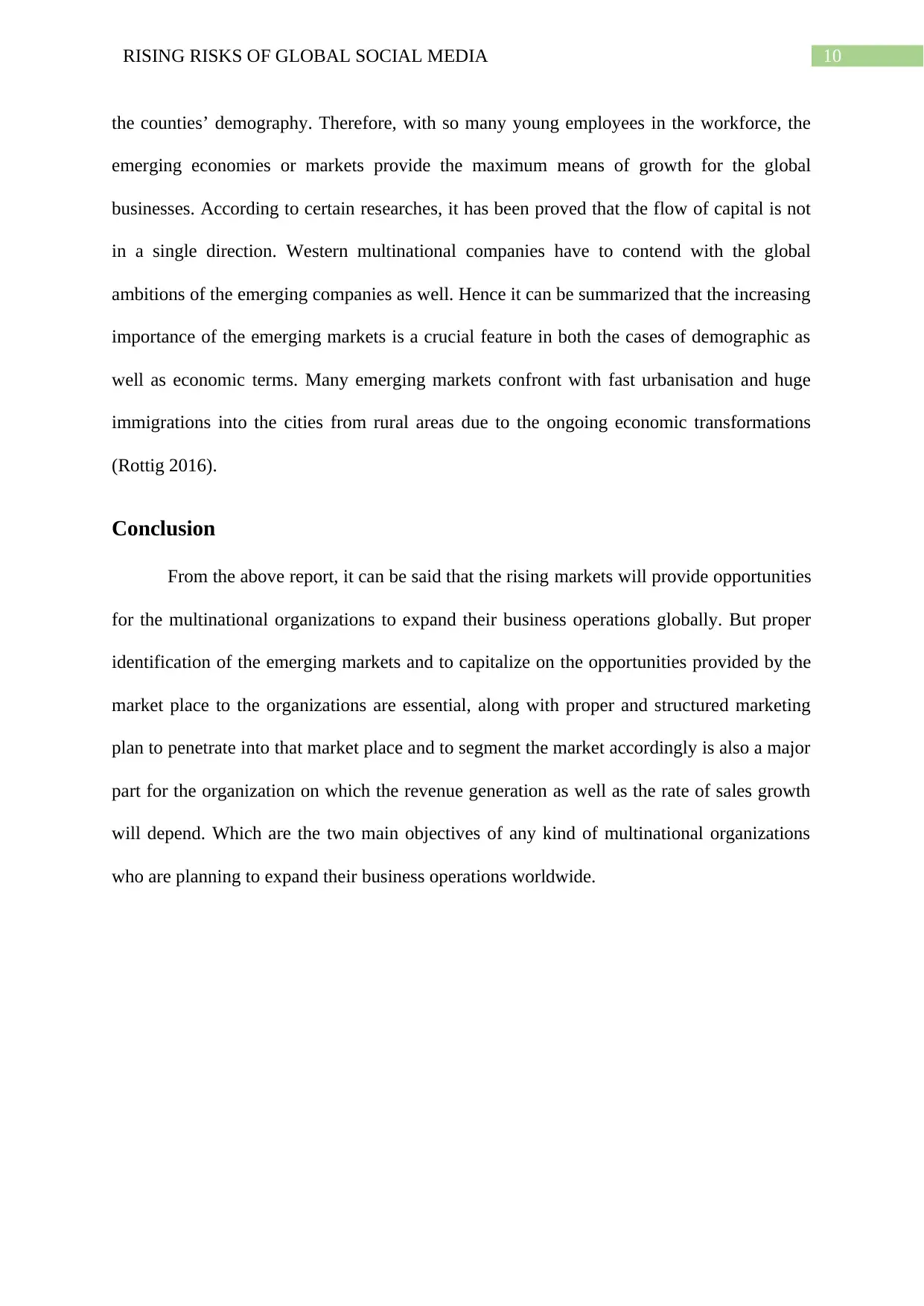
10RISING RISKS OF GLOBAL SOCIAL MEDIA
the counties’ demography. Therefore, with so many young employees in the workforce, the
emerging economies or markets provide the maximum means of growth for the global
businesses. According to certain researches, it has been proved that the flow of capital is not
in a single direction. Western multinational companies have to contend with the global
ambitions of the emerging companies as well. Hence it can be summarized that the increasing
importance of the emerging markets is a crucial feature in both the cases of demographic as
well as economic terms. Many emerging markets confront with fast urbanisation and huge
immigrations into the cities from rural areas due to the ongoing economic transformations
(Rottig 2016).
Conclusion
From the above report, it can be said that the rising markets will provide opportunities
for the multinational organizations to expand their business operations globally. But proper
identification of the emerging markets and to capitalize on the opportunities provided by the
market place to the organizations are essential, along with proper and structured marketing
plan to penetrate into that market place and to segment the market accordingly is also a major
part for the organization on which the revenue generation as well as the rate of sales growth
will depend. Which are the two main objectives of any kind of multinational organizations
who are planning to expand their business operations worldwide.
the counties’ demography. Therefore, with so many young employees in the workforce, the
emerging economies or markets provide the maximum means of growth for the global
businesses. According to certain researches, it has been proved that the flow of capital is not
in a single direction. Western multinational companies have to contend with the global
ambitions of the emerging companies as well. Hence it can be summarized that the increasing
importance of the emerging markets is a crucial feature in both the cases of demographic as
well as economic terms. Many emerging markets confront with fast urbanisation and huge
immigrations into the cities from rural areas due to the ongoing economic transformations
(Rottig 2016).
Conclusion
From the above report, it can be said that the rising markets will provide opportunities
for the multinational organizations to expand their business operations globally. But proper
identification of the emerging markets and to capitalize on the opportunities provided by the
market place to the organizations are essential, along with proper and structured marketing
plan to penetrate into that market place and to segment the market accordingly is also a major
part for the organization on which the revenue generation as well as the rate of sales growth
will depend. Which are the two main objectives of any kind of multinational organizations
who are planning to expand their business operations worldwide.
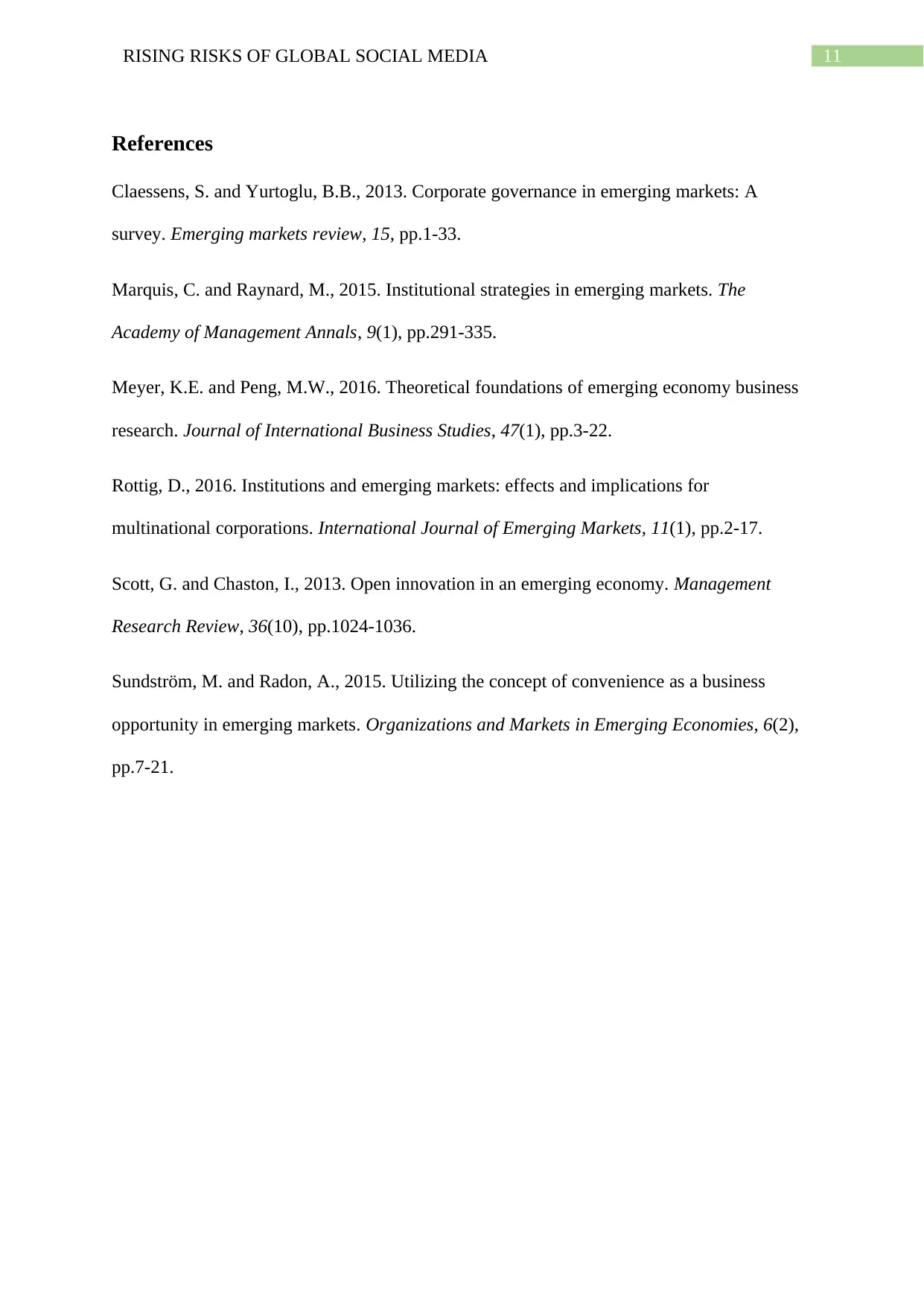
11RISING RISKS OF GLOBAL SOCIAL MEDIA
References
Claessens, S. and Yurtoglu, B.B., 2013. Corporate governance in emerging markets: A
survey. Emerging markets review, 15, pp.1-33.
Marquis, C. and Raynard, M., 2015. Institutional strategies in emerging markets. The
Academy of Management Annals, 9(1), pp.291-335.
Meyer, K.E. and Peng, M.W., 2016. Theoretical foundations of emerging economy business
research. Journal of International Business Studies, 47(1), pp.3-22.
Rottig, D., 2016. Institutions and emerging markets: effects and implications for
multinational corporations. International Journal of Emerging Markets, 11(1), pp.2-17.
Scott, G. and Chaston, I., 2013. Open innovation in an emerging economy. Management
Research Review, 36(10), pp.1024-1036.
Sundström, M. and Radon, A., 2015. Utilizing the concept of convenience as a business
opportunity in emerging markets. Organizations and Markets in Emerging Economies, 6(2),
pp.7-21.
References
Claessens, S. and Yurtoglu, B.B., 2013. Corporate governance in emerging markets: A
survey. Emerging markets review, 15, pp.1-33.
Marquis, C. and Raynard, M., 2015. Institutional strategies in emerging markets. The
Academy of Management Annals, 9(1), pp.291-335.
Meyer, K.E. and Peng, M.W., 2016. Theoretical foundations of emerging economy business
research. Journal of International Business Studies, 47(1), pp.3-22.
Rottig, D., 2016. Institutions and emerging markets: effects and implications for
multinational corporations. International Journal of Emerging Markets, 11(1), pp.2-17.
Scott, G. and Chaston, I., 2013. Open innovation in an emerging economy. Management
Research Review, 36(10), pp.1024-1036.
Sundström, M. and Radon, A., 2015. Utilizing the concept of convenience as a business
opportunity in emerging markets. Organizations and Markets in Emerging Economies, 6(2),
pp.7-21.
⊘ This is a preview!⊘
Do you want full access?
Subscribe today to unlock all pages.

Trusted by 1+ million students worldwide
1 out of 12
Related Documents
Your All-in-One AI-Powered Toolkit for Academic Success.
+13062052269
info@desklib.com
Available 24*7 on WhatsApp / Email
![[object Object]](/_next/static/media/star-bottom.7253800d.svg)
Unlock your academic potential
Copyright © 2020–2025 A2Z Services. All Rights Reserved. Developed and managed by ZUCOL.





